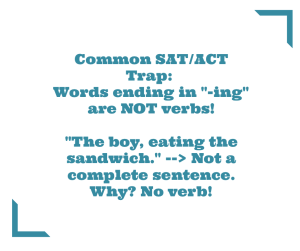Whenever you see a word ending in “-ing” on the SAT Writing or ACT English test, be on your guard. Words ending in “-ing” are commonly used to trap students into choosing wrong answers.
What’s so tricky about “-ing” words? They look like verbs, but they don’t grammatically count as verbs. Instead, “-ing” words can either be used as nouns (“gerunds”) or as adjectives (“present participles”). Here’s an example:
Running takes a lot of energy. –> Here, “running” is being used as a noun. It is the subject of the sentence; it is not a verb.
The boy, running away from house, felt free. –> Here, “running” is being used like an adjective to describe the boy; it is not a verb.
Running clocks are the best types of clocks. –> Here, “running” is being used like an adjective to describe clocks; it is not a verb.
The SAT and ACT will use this rule to try to trick you all the time. How? Every complete sentence needs two things: a subject and a verb. SAT and ACT questions will feature a sentence with a subject and an “-ing” word, and it will be up to you to recognize that this is not a complete sentence. For example:
The boy, eating the sandwich. –> Subject – the boy, check. Verb? Eating? Nope, that’s an “–ing” word. Not a complete sentence.
Don’t fall prey to this common trap. Be on the lookout for “-ing” words – they’ll often be masquerading as verbs!
